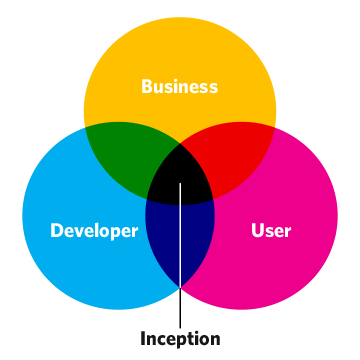You can trace most problems in software projects all the way back to the start. Maybe there was a large PDF of needs and requirements. A project kickoff meeting or call that had everyone nodding, but no one asking any questions. A set of goals for the project, but no understanding of how they support the goals of the business.
Any kind of software, app or website project involves three groups of people. You have the business team, who is asking for something to be done. You have the delivery team, the developers and the designers who are being asked to do it. And then you have the end users, who will be using it when it launches. It’s rare for a typical project kickoff meeting to include all three groups, and even rarer for the groups to talk to each other effectively. And that’s why projects fail. The business side will throw a big, long PDF over the wall to development. Development will try to read between the lines to decipher what to do. And neither side will get input from the end users to find out if they’re really building something silly.
We knew there had to be a better way. So years ago, we started asking our clients to give us two days of their undivided attention, leaving their fishbowl to come into ours for an Inception. The purpose was to get all three sides represented for a deep-dive into the client’s business, its needs and its capacity, so we could then determine what a project should look like. Because we’ve done these complex engagements so many times before, we’re able to ask questions that companies maybe haven’t even considered, but we know are crucial. We suss out what the scope should be, where the risks are, how we want to put together a team and how long it should take.
It’s an exciting two days that prevent many frustrations and misunderstandings and ultimately save our clients time and money.
Why Inceptions give our clients more value than the average project kickoff meeting
We’ll never know less about a project than we do at the start. But an Inception is an opportunity to make sure everyone shares a common vision. Instead of relying on assumptions, we can prod and question and validate as much as possible to come up with a shared understanding. Here’s our checklist of goals for an Inception:
1. Determine whether a project makes sense
The best thing an Inception can do for our clients is keep them from wasting money. Sometimes we’ll spend two days in the room, figuring out the scope, cost and duration of a project, only to realize it’s not going to be ROI positive. That’s a phenomenal outcome. If it sounds like a failure, think about the alternative. Our clients can stop the project with that discovery, and they’re only out two days, rather than months of design and custom development.
Other times we’ll recognize that based either on the money or the desires they have, it doesn’t make sense to go the custom route. Instead, they should take an existing product off the shelf. It’s kind of weird when you think about it, for a custom development company to tell people not to build custom software. But that happens. Our job in the Inception is to help the client find the best way to achieve their goals. That doesn’t always mean finding a way to create more custom software.
2. Decide if TXI is the right partner
That can extend to realizing that we’re not a good fit. Neither side wants to be locked into a six-month contract only to realize two weeks in that things aren’t clicking like they should be. If we’ve never worked with a client before, we want our first engagement to be something small. An Inception is a great introduction to new clients. Eventually we’ll build software. But an Inception lets us build a release plan first.
3. Develop a shared language
Words are super slippery. We need to define them. We’ve had clients write great documents explaining everything perfectly, but designers, software engineers, and end users can all interpret them differently. This is even true between stakeholders. By asking questions in an Inception, we’ll sometimes find that people who thought they were on the same page actually meant completely different things. We use a lot of facilitation techniques to translate prototypes and business processes into sticky notes and index cards so we can quite literally get everything out onto the table. By the end, we’re able to create definitions so we have the same level of understanding and can talk about things the right way.
4. Get feedback from strategists, designers, and engineers
The eventual goal of any software project is to have everyone working together on building the product. We just think that should happen in the envisioning stage too. Instead of a client meeting with only me or another member of our team, an Inception gives them a chance to actually meet with the team who is going to create their product. Our integrated team and can sit with them and say, “I hear what you’re saying, but that’s expensive, have you thought about this?” Those tips save us time building a plan that doesn’t take the realities of execution into account.
5. Ramp up quickly
After an Inception, we’re ready to go. There’s no game of telephone. You’ve already actually worked with the developer or designer who’s going to solve your problem. We know you and how to communicate with you, and you know the same. It makes it that much easier to jump into a project and get started.





